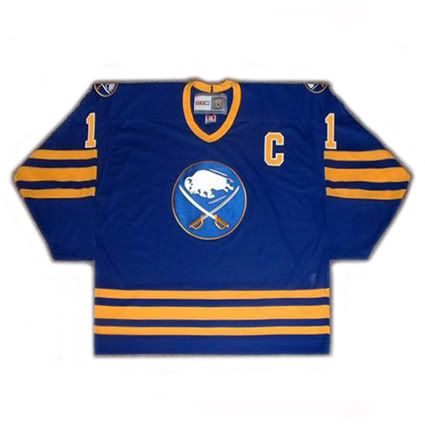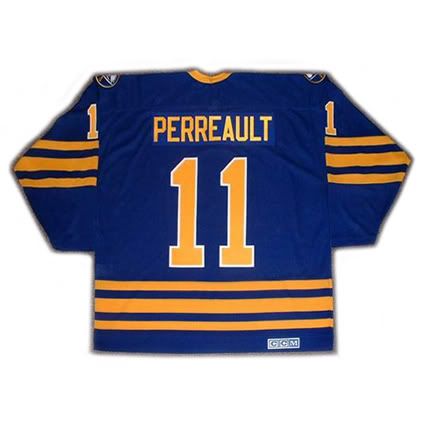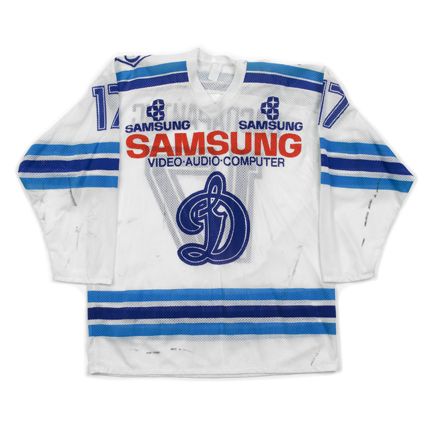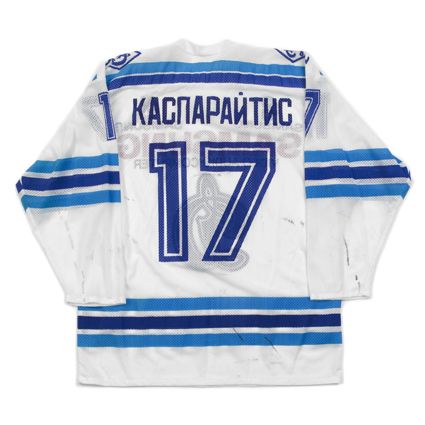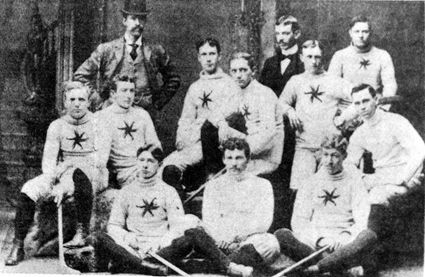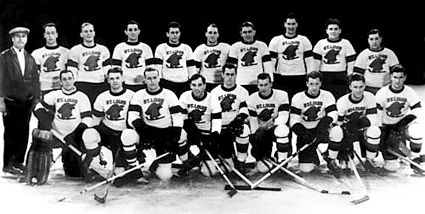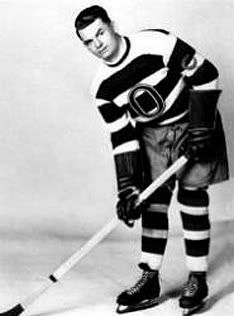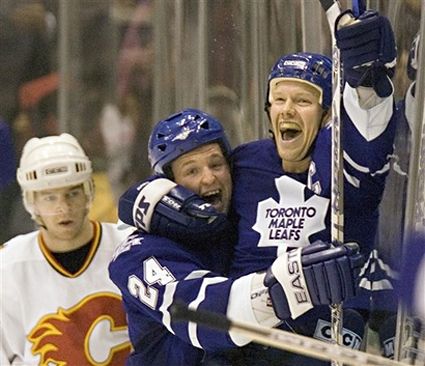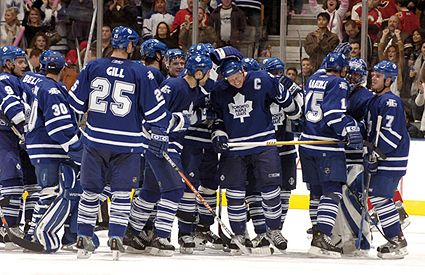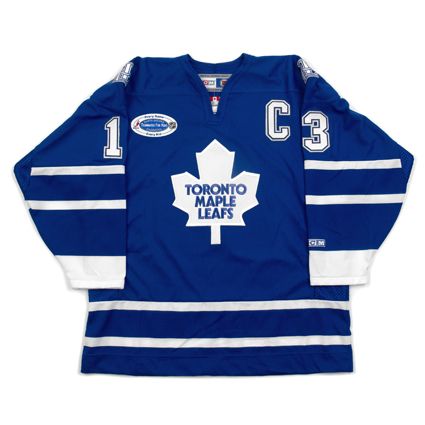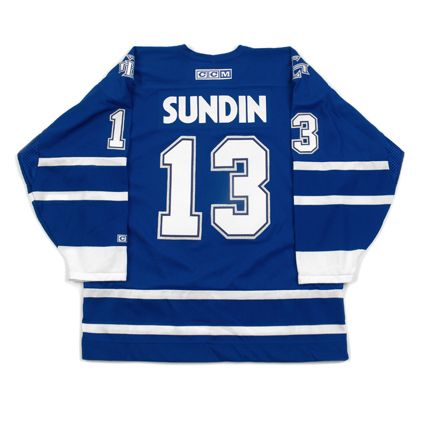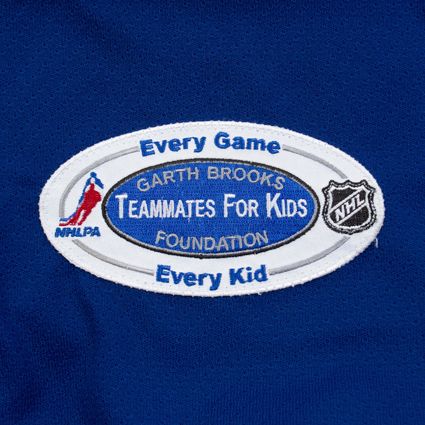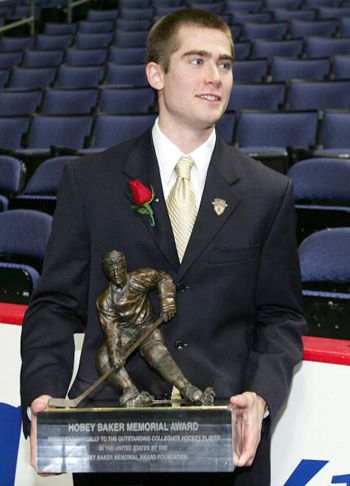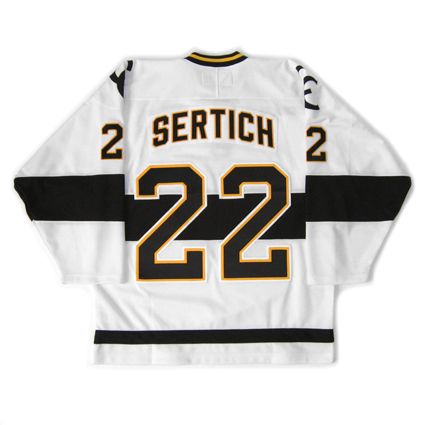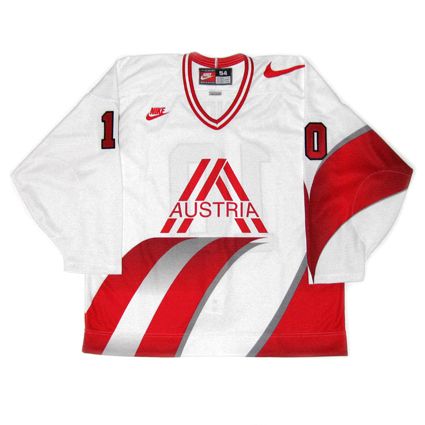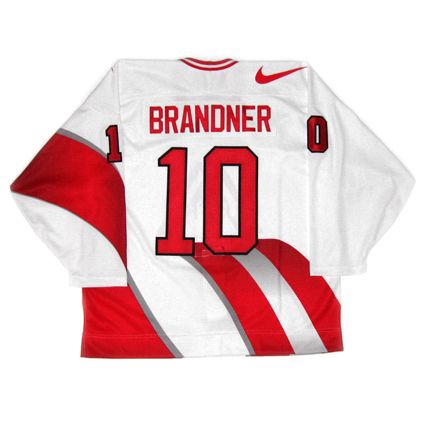Saturday, October 17, 2009
1983-84 Buffalo Sabres Gilbert Perreault Jersey
After seventeen seasons with the Buffalo Sabres, Gilbert Perreault had his #11 retired on this date in 1990, the only Sabre to ever wear #11.
The first ever draft pick for the fledgling Sabre organization, Perreault was drafted first overall in the 197o NHL Amateur Draft after the Sabres won a spin of a wheel to determine if they or the Vancouver Canucks would pick first. Sabres general manager Punch Imlach chose his favorite number 11, which proved lucky for the Sabres, and is why Perreault was assigned sweater #11.
Perreault scored a goal in the Sabres first ever game on October 10, 1970 and went on to lead the Sabres in scoring with 72 points in 78 games and win the Calder Trophy. He was also the first Sabre to record a power play goal and a hat trick.
Joined by wingers and fellow French-Canadians Rene Robert and Richard Martin during the Sabres second season, they formed "The French Connection" line which would excel for the seven seasons the trio played together, including all three being named to the same NHL All-Star Team on two occasions.
Perreault would lead the Sabres in scoring during 11 of his 17 seasons, including five in a row from 1975-76 to 1979-80. The Sabres would also qualify for the playoffs 11 consecutive seasons, including making it to the Stanley Cup Finals in 1975.
He would be named team captain in 1982, a position he would hold until his retirement in November 1986 and amass 512 goals and 814 assists for 1,326 points in his career in 1191 games - all Sabres franchise records which still stand to this day. He also holds Sabres career records for game winning goals, shots on goal and points in a game with seven.
He would also have the distinction of scoring the game winning goal in overtime of the 1978 NHL All-Star Game played in Buffalo at the Memorial Auditorium, one of nine NHL All-Star games he would appear in during his career.
In addition to his success with the Sabres, Perreault would also play for Team Canada during the 1972 Summit Series and the 1976 Canada Cup.
When he retired, he was the sixth leading scorer in NHL history and was subsequently inducted to the Hockey Hall of Fame in 1990.
Today's featured jersey is a 1983-84 Buffalo Sabres Gilbert Perreault jersey from the CCM vintage line. The Sabres played with essentially the same jerseys from 1970 to 1996 with only slight variations such as eliminating the original tie-neck collars in 1978, the same year they added shoulder logos, and minor changes to the arm and waist stripes in 1983.
This jersey proved so popular with the Sabres fans that it was brought back as a third jersey in 2006-07 and was modernized for a new third jersey again in 2008.
First, a real treat, footage from the first ever Buffalo Sabres game and Perreault's first ever NHL goal against Pittsburgh.
Here is the Legends of Hockey biography of Gilbert Perreault.
Next up is a great compilation of Perreault action highlights.
Finally a musical tribute to "The French Connection" line, featuring Gilbert Perreault.
Labels:
Buffalo Sabres,
Perreault Gilbert
Friday, October 16, 2009
1990-91 Dynamo Moscow Darius Kasparaitis Jersey
Born in Lithuania on this date in 1972, Darius Kasparaitis first played for Dynamo Moscow at the age of 16 during the 1988-89 season, the first Lithuanian to play in the Soviet Hockey League, and won the Soviet League Championship with Dynamo in 1992.
After his fourth season with Dyanmo, he was drafted by the New York Islanders with the 5th overall pick in the 1992 NHL Entry Draft. He jumped straight into the NHL later that year, playing in 79 games with the Islanders and announced his presence as a tough, physical player immediately as he led the team in hits, as well as scoring a career high 21 points on four goals and 17 assists.
After four seasons with the Islanders, he was traded to the Pittsburgh Penguins during the 1998-97 season where he would play six seasons, during which he would score one of the most notable goals in his career, a Game 7 overtime versus the Buffalo Sabres in the 2001 playoffs.
A late season trade in 2002 would see him play 11 games for the Colorado Avalanche and then sign the following season with the New York Rangers, where he would play parts of four seasons.
During the lockout year of 2004-05 he would join many other NHL players on Ak Bars Kazan of the Russian Super League.
2006-07 would see him return to Europe to play for SKA St. Petersburg on loan from the Rangers.
In international play, Kasparaitis has played for the Soviet Union in the 1990 European Junior Championships and the 1991 World Juniors, earning silver both times. 1992 would see him earn gold medals for the CIS/Unified Team in both the World Juniors, where he was named best defenseman, and Winter Olympics in Albertville, France.
With the political situation in Russia now resolved, Kasparaitis would now play for Russia in the 1992 and 1996 World Championships, the 1996 and 2004 World Cup of Hockey and the 1998, 2002 and 2006 Olympics, earning a bronze in 2002 and a silver in 1998.
Today's featured jersey is a 1990-91 Dynamo Moscow Darius Kasparaitis jersey. It's very typical of Soviet jerseys of the time period in that it is a light weight mesh with all the graphics silk screened onto the jersey with the name on the back being a classic example of Cyrillic lettering. The jersey shows good game use with several black stick marks on the arms and body.
Elvis has left the building as Kasparaitis scores his Game 7 overtime versus the Buffalo Sabres in the 2001 playoffs.
Here is an interview with Kasparaitis and his hair before the 2006 Olympic Games.
Finally a compliation of hits by Kasparaitis from the 1993-94 season.
Labels:
Dynamo Moscow,
Kasparaitis Darius
Thursday, October 15, 2009
1934-35 St. Louis Eagles Frank Finnigan Jersey
The original Ottawa Senators were founded back in 1883 as an amateur club and later became a professional team. In the early years of hockey they moved from league to league as the organization of early hockey was still finding it's feet. Aside from the changes in leagues, the club also took some time to settle on a permanent nickname as well. Known as the Generals in the 1890's, the club was known as the Silver Seven from 1903 to 1907 before adopting the name Senators starting in 1912.
After winning the championship in 1927, the Senators began a decline in fortunes, primarily due to the small size of Ottawa when compared to the other cities in the league at the time. Ottawa's population in 1931 was 110,000, one-fifth the size of Toronto, which was the second smallest NHL city at the time. They began to sell off their best players, suffered from low attendance at home against new expansion teams, such as the Boston Bruins, Chicago Blackhawks, Detroit Cougars, New York Americans, New York Rangers and Pittsburgh Pirates, and the higher travel costs to play those same teams in the United States.
The club finished with a dismal record of 11-31-6 for last in the league, while they again were forced to sell players, including team captain Syd Howe who lead the team in goals despite being traded to Detroit late in the season to help meet expenses. Finally on October 15th, 1935 the owners of the franchise sold the club back to the NHL for $40,000 and the players were then sold off to the remaining eight clubs in the league.
One of the most successful teams in the early days of hockey, the club won the Stanley Cup in 1903, 1904, 1905, 1906, 1909, 1910 and again in 1911 during the cup's "challenge era".
By then the team had joined the National Hockey Association, which lasted from 1910 to 1917. After the NHA dissolved, the Ottawa Senators joined the brand new National Hockey League as a charter member in 1917 and soon rose to prominence, capturing four more Stanley Cups in 1920, 1921, 1923 and 1927.
The Great Depression also affected the team and caused the sale of even more players, including King Clancy to Toronto. The team suspended operations for the 1931-32 season and returned to finish with the worst record in the league two years in a row. Finally the owners of the franchise announced that it would not return to Ottawa for the 1934-35 season due to losses of over $60,000 since resuming play and would relocate the team.
The franchise then moved to St. Louis, the seventh largest city in the US at the time, for the 1934-35 season and was named the Eagles after the Anheuser-Busch beer logo. While attendance was good, the team fared little better financially in St. Louis however, with long, expensive train trips to New York and Boston as well as a large number of games against Montreal and Toronto, as the poor Eagles were forced to take Ottawa's place in the Canadian Division of the NHL despite being located much closer to Chicago and Detroit of the American Division.
It would be 32 years before the NHL would return to St. Louis when the Blues joined the league in 1967.
Today's featured jersey is a 1934-35 St. Louis Eagles Frank Finnigan jersey worn by Finnigan during the St. Louis Eagles only season.
Finnigan was born in 1900 and played in the NHL from 1923 to 1937 for Ottawa, Toronto and St. Louis and was nicknamed the "Shawville Express".
He would win a Stanley Cup with Ottawa in 1927 and was team captain from 1930 to 1933, scoring a career high of 21 goals and 36 points in the 1929-30 season during 43 games played. He played in Toronto the season Ottawa suspended play, winning his second Stanley Cup with the Maple Leafs, and returned to Toronto after being one of the players sold by St. Louis in 1935. He also held the distinction of having played in the first NHL All-Star Game in 1934, which was held as a benefit for Toronto player Ace Bailey.
In 1989 Finnigan was part of the effort to bring back NHL hockey to Ottawa and made public appearances on behalf of the effort and was part of the presentation to the NHL expansion committee at the age of 90. He was scheduled to drop the puck at the first new Senators game in October of 1992, but passed away the previous December at the age of 91, the last surviving member of the 1927 Stanley Cup champions. Finnigan's son, Frank Jr., was chosen to drop the ceremonial first puck in his place.
On the night of the first game new Senators game, Finnigan's number 8 was retired by the club, still the only number retired by the team other than the league-wide retirement of Wayne Gretzky's #99.
In addition to having his jersey number retired, the street in front of the Senators arena, Scotiabank Place, was named Frank Finnigan Way in his honor.
Here is video from the first game of the new Ottawa Senators on October 8, 1992, including the opening of Hockey Night in Canada on that day and the first Senators goal of the new era.
Here is a brief recap of the original Senators history and how it influenced the branding of the newly reborn Senators.
Labels:
Finnigan,
Ottawa Senators,
St. Louis Eagles
Wednesday, October 14, 2009
2006-07 Toronto Maple Leafs Mats Sundin Jersey
On this date in 2006, the Calgary Flames traveled to Toronto to take on the Maple Leafs. Darcy Tucker opened the scoring at 8:09 of the first period with assists from Kyle Wellwood and Mats Sundin on a power play to give Toronto a 1-0 lead. Sundin extended the Toronto lead to 2-0 at 15:28 from a beautiful cross-ice pass from Brian McCabe with a second assist going to Jeff O'Neill.
The second period saw the Flames roar back with three goals in less than 12 minutes, as Mark Giordano scored at 4:52 followed by a shorthanded goal by Matthew Lombardi at 7:53 followed by Giordano's second of the period at 11:26 to give Calgary a 3-2 lead.
Alex Steen tied the game for Toronto at 17:38 from Matt Stajan and Chad Kilger. Sundin then restored the lead for the Maple Leafs lead for the second time with a goal at 18:48 from Tucker and Ian White after a drop pass from Tucker, which Sundin gathered up and quickly fired a laser shot over Miikka Kiprusoff's left shoulder and into the upper corner of the net.
The Maple Leafs lead would not hold up however, as Calgary's Daymond Lankow tied the game once more with a goal at 7;15 of the third period. The remainder of regulation passed with plenty of chances, as the Flames took 15 shots in the period while Toronto had 13 of their own, but
Kiprusoff and Toronto's Andrew Raycroft held firm and regulation ended in a 4-4 tie, but not before Tucker took a hooking penalty with just eight seconds remaining in the period.
Overtime then began with Toronto a man down, but a turnover by Alex Tanguay led to a rush by Mats Sundin, who skated down the left hand side and, once over the blueline, fired a shot from a long way out, which eluded Kiprusoff to not only win the game for the Maple Leafs, but also made Sundin the first Swedish player, and 35th of all time, to score 500 goals in the NHL, and in style too, as his milestone 500th goal came not only both shorthanded and unassisted, but also completed a hat trick in front of the delirious home fans at the Air Canada Centre!
The second period saw the Flames roar back with three goals in less than 12 minutes, as Mark Giordano scored at 4:52 followed by a shorthanded goal by Matthew Lombardi at 7:53 followed by Giordano's second of the period at 11:26 to give Calgary a 3-2 lead.
Alex Steen tied the game for Toronto at 17:38 from Matt Stajan and Chad Kilger. Sundin then restored the lead for the Maple Leafs lead for the second time with a goal at 18:48 from Tucker and Ian White after a drop pass from Tucker, which Sundin gathered up and quickly fired a laser shot over Miikka Kiprusoff's left shoulder and into the upper corner of the net.
The Maple Leafs lead would not hold up however, as Calgary's Daymond Lankow tied the game once more with a goal at 7;15 of the third period. The remainder of regulation passed with plenty of chances, as the Flames took 15 shots in the period while Toronto had 13 of their own, but
Kiprusoff and Toronto's Andrew Raycroft held firm and regulation ended in a 4-4 tie, but not before Tucker took a hooking penalty with just eight seconds remaining in the period.
Overtime then began with Toronto a man down, but a turnover by Alex Tanguay led to a rush by Mats Sundin, who skated down the left hand side and, once over the blueline, fired a shot from a long way out, which eluded Kiprusoff to not only win the game for the Maple Leafs, but also made Sundin the first Swedish player, and 35th of all time, to score 500 goals in the NHL, and in style too, as his milestone 500th goal came not only both shorthanded and unassisted, but also completed a hat trick in front of the delirious home fans at the Air Canada Centre!
"It's a special way to get it. I'll remember this day throughout my whole life," Sundin said following the game.
Combined with his assist on the first Toronto goal, his hat trick gave him four points on the memorable night. The winning goal was his 15th overtime goal of his career, the most in NHL history at the time.
Even Flames captain Jarome Iginla had to admire Sundin on the night. "He was really going tonight. It was an amazing shot on that last goal. Not many people would have stopped that. He got a screen and he got it all. You don't want to call it a nice goal, but it was impressive," said Iginla.
Today's featured jersey is a 2006-07 Toronto Maple Leafs Mats Sundin jersey, from the season he scored his 500th career goal and 900th point as a Maple Leaf.
This particular jersey features the Teammates for Kids patch, as worn by Sundin and his Maple Leafs teammates on January 6th, 2007.
As part of the program, each player on every team would play one game with the patch on their jerseys, which would then be auctioned off for chairity to raise money for the Garth Brooks Teammates for Kids Foundation. This would result in over 600 game worn jerseys entering the market in a single go.
As part of the program, each player on every team would play one game with the patch on their jerseys, which would then be auctioned off for chairity to raise money for the Garth Brooks Teammates for Kids Foundation. This would result in over 600 game worn jerseys entering the market in a single go.
Today's featured video is Sundin scoring four points in the game on October 14th, 2006, concluding with him scoring his milestone 500th career goal shorthanded in overtime to complete his hat trick and defeat the Calgary Flames 5-4, sending the home crowd into euphoria.
Labels:
Sundin Mats,
Toronto Maple Leafs
Tuesday, October 13, 2009
2004-05 Colorado College Tigers Marty Sertich Jersey
Born on this date in 1982, Colorado College's Marty Sertich was named the winner of the annual Hobey Baker Award in 2005 following a season in which he had a collegiate career highs in goals (27), assists (37) and points (64) and was the leading scorer in all of NCAA hockey, edging out teammate Brett Sterling by a single point while leading the Tigers to the NCAA Frozen Four for the first time in eight seasons. He was also named a First-team All-American, WCHA Player of the Year and USA Hockey's College Player of the Year.
He joined 2003 winner and former St. Louis Blues player Peter Senja as the only other Hobey Baker winner from Colorado College.
The following season Sertich was once more named a finalist for the Hobey Baker Award while serving as team captain.
Following the conclusion of his college career, in which he never missed a game, Sertich signed a contract with the Dallas Stars and spent two years in Des Moines playing for the Iowa Stars of the AHL, scoring 27 goals and 25 assists for 52 points in 2007-08 and leading the Stars in goals and power play goals. During the offseason in 2008, he was traded to the Colorado Avalanche and spent the season in Cleveland with the Lake Erie Monsters, also of the AHL as he continues to work toward making his NHL debut.
Beginning in 1938, the Colorado College Tigers hockey program has made the NCAA Tournament 18 times, taking the national championship in 1950 and 1957 and finishing as runner up in 1952, 1955 and 1996. Former Pittsburgh Penguins head coach Bob Johnson coached the Tigers from 1963 to 1966. They have won the WCHA league title nine times since the formation of the conference in 1959. Arguably, the best known Colorado College player in the NHL is former Vancouver Canuck and New York Ranger Doug Lidster, who played 897 NHL games over 16 seasons.
Today's featured jersey is a 2004-05 Colorado College Tigers Marty Sertich jersey as worn during his Hobey Baker winning season. This jersey has it all going for it. The sharp logo, classic center stripe, three color numbers, vertically arched name, classic interlocking letters of the shoulder logos and a tie-neck collar.
The modern, graphic Tiger head logo has always been a favorite with us, and, in combination with the retro feeling of the center "Canadiens" stripe around the body of the jersey really makes for an attractive combination. We're surprised more teams don't use the central stripe as a design element.
Here is a small collection of Sertich and Colorado College videos that highlight the history of the program.
Labels:
Colorado College,
Sertich Marty,
WCHA
Monday, October 12, 2009
1997 Austria National Team Christoph Brandner Jersey
On this date in 2003, Christoph Brandner of the Minnesota Wild became the first Austrian player to score a goal in the NHL.
Brandner, a native of Bruck an der Mur, Austria began his playing career for Kapfenberg of the Austrian League in 1994 before moving on to Klangenfurt AC, where he would play for three seasons. The 2000-01 season would see Brander move to Krefeld Penguine (Penguins) of the German DEL. While playing in Krefeld, he would be drafted in the 8th round of the 2002 NHL Entry Draft by the Minnesota Wild. He would remain in Germany for one more season before coming over to North America and making the Wild roster out of training camp.
After becoming the first Austrian to play in the NHL during the Wild's season opener on October 8th, he would become the first Austrian to score a goal (and point) in the NHL when he beat the San Jose Sharks Vesa Toskala at 6:24 of the first period.
Brandner would play 35 games for the Wild, scoring 4 goals and 5 assists for 9 points before being assigned to Houston of the AHL for the remainder of the season, unfortunately ending his NHL career. He would return to Houston again the following year before heading back to Europe in 2005-06, first in the Swedish Elitserien with Södertälje SK before moving back to the DEL with the Hamburg Freezers for two seasons. 2008-09 would see him return to his native Austria and be reunited with Klagenfurt AC.
His best professional season was in 2002-03 with Krefeld of the DEL when he would lead the league in goals, be named the Best Winger as well as League MVP and help Krefeld win the 2003 DEL Championship with 18 points in 14 playoff games in addition to his 45 points in 49 regular season games.
Brandner has also suited up for the Austrian National Team on 11 occasions, the first of which was the 1993 World Junior Championships "B" pool. He would eventually play in three World Juniors and one European Junior Championship.
1997 would see him make his World Championship debut, again in the "B" pool. With Austria now promoted to the Top Division of the World Championships and Brander would compete for Austria at the World Championships again in 2000, 2001, 2002, 2003 and help them win Division 1 Group A in 2008 to return to the Top Division with 4 goals and 5 points in 5 games.
He would also play for Austria in the 2002 Winter Olympics in Salt Lake City. His international record currently shows 68 games played, 29 goals and 17 assists for 46 points.
Brander would be followed in the NHL by Austrians Reinhard Divis, a goaltender for the St. Louis Blues for 28 games over four seasons, Andreas Nödl of the Philadelphia Flyers, Thomas Pöck of the New York Rangers and later the New York Islanders and the most successful Austrian to date, NHL All-Star Thomas Vanek of the Buffalo Sabres, now in his fifth NHL season with 260 points to his credit through the 2008-09 season.
Today's featured jersey is a 1997 Austrian National Team Christoph Brandner jersey as worn in the 1997 World Championships "B" pool. The "waving flag" style of international jerseys were introduced in 1996 and are best known for being used in the 1996 World Cup of Hockey. They were also used in the various World Championships in 1997 before a new style was debuted for the 1998 Winter Olympic Games in Japan.
Brandner scored a goal and two assists in seven game for Austria at the 1997 World Championships.
Today's first video highlight is Brandner scoring his first goal, the first by an Austrian in NHL history.
Next up is Brandner scoring for Austria in the 2008 World Championships versus the Netherlands.
Labels:
Austria,
Brandner Christoph
Sunday, October 11, 2009
2000-01 Minnesota Wild Cam Stewart Jersey
On this date in 2000 the Minnesota Wild made their home debut at the Xcel Energy Center in St. Paul, Minnesota.
The first ever Wild game came on the road in Anaheim against the Mighty Ducks in a 3-1 loss on October 6th, followed the next night by a 4-1 defeat in Phoenix versus the Coyotes.
Four days later the team would begin a new era of NHL hockey in Minnesota as they would host the Philadelphia Flyers in their brand new arena.
Following the retirement of jersey #1 in honor of the fans, NHL hockey faced off for the first time in Minnesota in seven seasons following the departure of the Minnesota North Stars for Dallas, Texas.
Peter White of the Flyers opened the scoring at 13:41 of the first period, beating Wild goaltender Manny Fernandez. It would take less than four minutes for Minnesota native Darby Hendrickson to score the first Wild goal at home in franchise history at 17:19 with an assist from the enigmatic Maxim Shushinski, who would last just 30 games in the NHL before returning home to Russia.
Both teams would be held off the scoreboard for the majority of the second period until the Wild's first ever draft pick Marian Gaborik would score a power play goal, the first in Wild history, during the last minute of the second, at 19:05, giving the Wild a 2-1 lead after two despite being outshot 10-3 in the period.
White would get his second of the game at 5:43 of the third to pull the Flyers back into a tie before the hard working Wes Walz, back in the NHL after four seasons in Switzerland, would shock the Flyers with a shorthanded goal at 9:12. Eric Desjardins would even the score at 3-3 with a goal just over a minute later at 10:37. Each team would survive a power play chance for the other club before regulation time would expire with the teams deadlocked at 3.
Overtime would see the Wild kill off another penalty as the Flyers would outshoot the Wild 7-2 in the extra period but the game would end still tied.
Fernandez would make 36 saves against 19 for the Flyers Brian Boucher in front of a sell-out crowd of 18,827.
NHL Commissioner Gary Bettman was in attendance and was quoted as saying "Minnesota and hockey is a no-brainer." as well as "I'm sorry we left. Bringing pro hockey back here was by far the right thing to do."
The Wild would finish their first season 25-39-13-5 for 68 points, last in the Northwest Division. They would be led in scoring by Scott Pellerin with 39 points in 58 games before trading him, along with several other veteran players at the trade deadline. Gaborik, Walz and Hendrickson would lead the team in goals with 18 apiece.
Today's featured jersey is a game worn CCM 2000-01 Minnesota Wild Cam Stewart jersey. This jersey is a "set one" jersey, meaning it was worn in the Wild's home debut at the Xcel Energy Center, the first time the team would wear their white jerseys in a regular season contest.
Stewart, started his NHL career with the Boston Bruins after being drafted in the third round out of the University of Michigan, playing 83 games over four seasons, before playing two seasons for the Houston Aeros of the IHL, helping them win the Turner Cup in 1999.
1999-00 would see Stewart play 65 games with the Florida Panthers before being claimed by the Wild in the 2000 Expansion Draft. He would play 54 games for Minnesota in 2000-01 but would have his playing career cut short by a concussion in training camp before the following season, which would cause him to miss the entire year before announcing his retirement in June of 2002. His final NHL totals would show 202 games played, 16 goals and 23 assists for 39 points as well as an additional 13 playoff games with a goal and three assists.
Our first video today is the introductory video played before each Wild home game at "The X", featuring scenes of hockey from around the state throughout history.
This next one is a version of the Minnesota Wild anthem, this time featuring the lyrics to the song, along with more footage of hockey from around the state which includes Darby Hendrickson's first ever home goal for the Wild versus Philadelphia.
Following the opening video, each game is started with an honorary "Let's Play Hockey" chant. The first example is Natalie Darwitz showing how it's done, followed by the Minnesota Vikings Adrian Peterson with his own, uh, creative interpretation of the three word chant.
Last up is "A Day in the Life" with Hendrickson, filmed during the Wild's first season on the date of the Dallas Stars first game back in Minnesota since the franchise relocated to Texas, a stunning 6-0 thrashing of the Stars by the expansion Wild.
Labels:
Minnesota Wild,
Stewart Cam
Subscribe to:
Comments (Atom)

